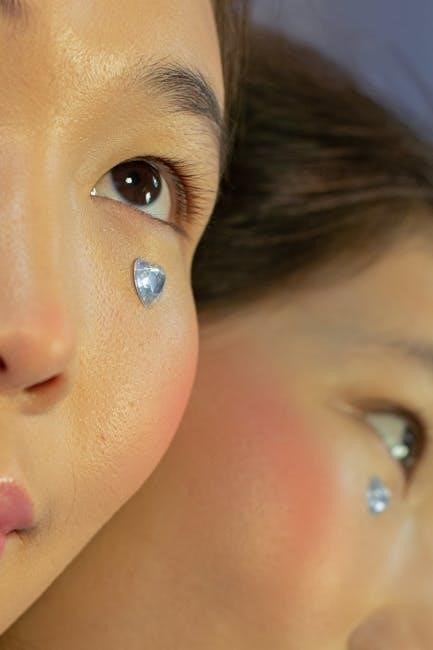rhinestone size guide
Summary
Discover the ultimate rhinestone size guide! Sparkle with style and confidence. Find your perfect fit today at The Suicide King.

This guide provides essential insights into rhinestone sizes, helping crafters and designers choose the perfect stones for their projects. With detailed charts and expert tips, it ensures precision and creativity in selecting rhinestones, from tiny embellishments to bold statement pieces. Whether for jewelry, clothing, or DIY crafts, this guide offers a comprehensive understanding of size systems and applications.
1.1 Understanding the Importance of Rhinestone Sizes
Rhinestone sizes play a crucial role in determining the visual impact and functionality of a project. Choosing the right size ensures a balanced design, proper coverage, and durability. Whether for intricate jewelry or bold fashion statements, understanding size options helps crafters achieve professional results. A well-selected size enhances creativity and ensures projects look polished and cohesive.
1.2 Brief Overview of Rhinestone Measurement Systems
Rhinestones are measured using two primary systems: PP (Pearl Plate) and SS (Stone Size). PP is typically used for smaller stones, while SS is the standard for larger ones. These systems help crafters and designers determine the ideal size for their projects, ensuring accuracy and consistency. Understanding these systems is key to selecting the right rhinestones for any creative endeavor.
Rhinestone Measurement Systems
Rhinestones are measured using PP (Pearl Plate) and SS (Stone Size) systems. PP is for smaller stones, while SS is used for larger ones. These systems provide consistent sizing for crafting and design projects, ensuring accurate measurements and practical applications.
2.1 PP (Pearl Plate) Size System
The PP (Pearl Plate) system, originally used for pearls, measures smaller rhinestones by passing them through holes on a plate. Sizes range from PP1 to PP21, with each size varying by 0.1mm. This method is ideal for pinpointing precise measurements for intricate designs, ensuring a perfect fit for delicate craftsmanship. It remains a reliable option for selecting tiny stones.
2.2 SS (Stone Size) System
The SS (Stone Size) system is the most common method for measuring rhinestones, particularly for larger stones. Sizes range from 1ss to 48ss, with each ss corresponding to specific millimeter measurements. This system is widely used for flat-back and larger point-back rhinestones, offering precise sizing for various applications. It is often preferred for its clarity and consistency in modern crafting and jewelry-making projects.
2.3 Millimeter and Inch Conversions
Rhinestone sizes are often converted between millimeters and inches for precise measurements. For example, SS12 rhinestones measure approximately 3mm or 0.12 inches, while SS16 stones are about 4mm or 0.16 inches. These conversions are essential for project planning, ensuring accurate sizing for jewelry, clothing, or craft designs. They help crafters align rhinestones with other materials, making the design process smoother and more efficient.
Rhinestone Size Chart

This chart provides a clear comparison of rhinestone sizes, listing SS and PP designations alongside their millimeter and inch equivalents. It helps crafters and designers select the perfect stones for their projects, ensuring accurate sizing and compatibility.
3.1 Common Rhinestone Sizes and Their Uses
Rhinestones range from 1ss to 48ss, with smaller sizes (1ss-10ss) ideal for intricate designs, while larger sizes (12ss-24ss) are perfect for bold statements. Sizes like 16ss and 20ss are popular for jewelry and clothing, offering versatility. Larger stones (26ss and above) are great for decorative accents, adding drama to projects. Each size caters to specific crafting needs, ensuring the right sparkle for any design.

3.2 Printable Rhinestone Size Chart for Crafters
A printable rhinestone size chart is a valuable tool for crafters, offering a true-to-size reference for comparing rhinestone sizes. It includes SS, PP, millimeter, and inch equivalents, along with visual representations for easy comparison. This chart helps in project planning, purchasing, and estimating stone quantities. Compatible with standard printers, it can be laminated for durability, making it a practical addition to any crafter’s toolkit.
Choosing the Right Rhinestone Size for Your Project
Selecting the ideal rhinestone size involves considering design complexity, project type, and desired visual impact. Proper fit ensures durability and aesthetic appeal, making it crucial for a polished finish.
4.1 Factors to Consider When Selecting Rhinestone Sizes
When choosing rhinestone sizes, consider the project’s scale, design complexity, and intended use. Smaller stones (1ss-10ss) are ideal for intricate details, while larger ones (26ss+) make bold statements. Material, durability, and application method also matter. Ensure the size complements the base material, whether fabric, jewelry, or other surfaces, for a balanced and professional finish.
4.2 Popular Rhinestone Sizes and Their Applications
Popular rhinestone sizes include 12ss, 16ss, and 20ss, offering versatility for various projects. Smaller sizes (3ss-10ss) are ideal for intricate designs and nail art, while medium sizes (12ss-24ss) suit jewelry and embroidery; Larger sizes (26ss+) create bold statements in fashion and home decor. Each size caters to specific needs, ensuring the right sparkle and impact for any creative endeavor.
How to Measure Rhinestones
Measure rhinestones using calipers or a sizing chart for accuracy. Compare stones to a reference guide or use a ruler to determine their SS or PP size effectively.
5.1 Tools for Measuring Rhinestones
Essential tools for measuring rhinestones include digital calipers for precise millimeter readings, vernier calipers for accuracy, and sizing charts for quick comparisons. A rhinestone sizing tool with rulers (in inches and millimeters) and holes for measuring is also handy. Additionally, comparing stones to common objects, like the head of a pin or a dime, provides a practical reference for estimating sizes effectively.
5.2 Estimating Rhinestone Sizes for Projects
Estimating rhinestone sizes involves considering the project’s scale, design complexity, and desired visual impact. Using size charts and visual references, crafters can match stones to their needs. Comparing rhinestones to common objects, like a pinhead or dime, helps approximate sizes. For intricate designs, smaller stones (1ss-10ss) are ideal, while larger stones (26ss+) suit bold statements. This method ensures a balanced and polished final look.
Rhinestone Size Applications
Rhinestones are used in various crafts, from jewelry to clothing. Small sizes (1ss-10ss) are ideal for intricate designs, while larger stones (26ss+) create bold, eye-catching accents. Versatile and sparkling, they enhance any project with precision and style, making them a favorite for crafters and designers alike.
6.1 Uses of Small Rhinestones (1ss to 10ss)
Small rhinestones (1ss to 10ss) are perfect for delicate designs and intricate details; They are ideal for jewelry making, embroidery, nail art, and DIY crafts. These tiny stones add subtle sparkle to projects like beadwork, fabric embellishments, and hair accessories. Their compact size allows for precise placement, making them a favorite for creating detailed, high-quality designs that require finesse and a touch of elegance.
6.2 Uses of Medium Rhinestones (12ss to 24ss)
Medium rhinestones (12ss to 24ss) are versatile and widely used for adding moderate sparkle to various projects. They are ideal for clothing embellishments, accessories like belts or bags, and home decor items. These sizes are also popular in dance costumes, pageant outfits, and DIY crafts where a noticeable yet balanced amount of bling is desired. Their size makes them suitable for creating eye-catching designs without overwhelming the piece.
6.3 Uses of Large Rhinestones (26ss and Above)
Larger rhinestones (26ss and above) make bold statements, perfect for creating dramatic effects. They are often used in stage costumes, high-end fashion, and statement jewelry. These sizes are ideal for centerpieces, elaborate designs, and decorative accents where maximum visibility is desired. Their substantial size draws attention, making them a popular choice for professional crafters and designers seeking to add luxurious flair to their work.
Rhinestone Size Conversion Guide
This section provides a detailed guide to converting rhinestone sizes between PP, SS, and millimeter measurements, ensuring accuracy for crafters and designers in project planning and execution.
7.1 Converting PP to SS Sizes
Converting PP (Pearl Plate) to SS (Stone Size) involves understanding their measurement systems. PP sizes, originally for pearls, have variances of 1/10 mm, while SS sizes are more precise. For example, PP1 converts to SS26, and PP3 to SS9. This guide helps crafters align PP and SS sizes accurately, ensuring the right fit for their projects. Use this chart to seamlessly transition between systems and achieve desired results.
7.2 Converting Millimeter to SS Sizes
Converting millimeter measurements to SS (Stone Size) is essential for precise project planning. SS sizes correspond to specific millimeter ranges, with smaller numbers indicating smaller stones. For example, SS3 is approximately 0.8-1.0 mm, while SS16 is around 4.0 mm, and SS40 is about 9.5 mm. This guide provides a clear correlation between millimeter measurements and SS sizes, ensuring accurate conversions for various crafting needs.
Printable Rhinestone Size Chart
A quick reference guide, this chart includes SS and PP sizes with millimeter and inch equivalents, visually comparing rhinestone sizes for accurate project planning and purchasing.
8.1 How to Use the Printable Chart

Print the chart on standard 8.5×11 paper for easy reference. Use it to compare rhinestone sizes visually, ensuring accurate measurements for your projects. Match SS and PP sizes with millimeter equivalents to avoid errors. Store it with crafting tools for quick access, aiding in project planning and purchasing decisions. This tool is invaluable for crafters, ensuring precision and convenience.
8.2 Benefits of a Printable Size Chart for Crafters
A printable size chart offers crafters a quick reference guide, saving time and ensuring accuracy. It provides visual comparisons of sizes, helping to avoid errors. The chart is portable, usable offline, and can be stored with crafting tools. It’s also a cost-effective resource, offering clear conversions between SS, PP, and millimeter measurements. This tool is especially helpful for beginners, enhancing creativity and efficiency in rhinestone projects.
This guide provides a comprehensive understanding of rhinestone sizes, ensuring accuracy and creativity in crafting. Use the charts and tips to elevate your projects and achieve professional results.
9.1 Summary of Key Points
This guide has covered the essential aspects of rhinestone sizing, from understanding SS and PP systems to practical application tips. Key points include the importance of size accuracy, the use of conversion charts, and how to measure stones effectively. By mastering these concepts, crafters can confidently select the right rhinestones for their projects, ensuring both functionality and aesthetic appeal.
9.2 Final Tips for Working with Rhinestones

Always use a sizing tool or chart for precise measurements. Store rhinestones by size to avoid mixing. Test adhesives on a small area first. Plan projects carefully, considering both size and quantity. For intricate designs, start with smaller stones and build up. Practice on scrap material to ensure techniques are flawless. Happy crafting!